Using vignettes to understand decision-making processes within households
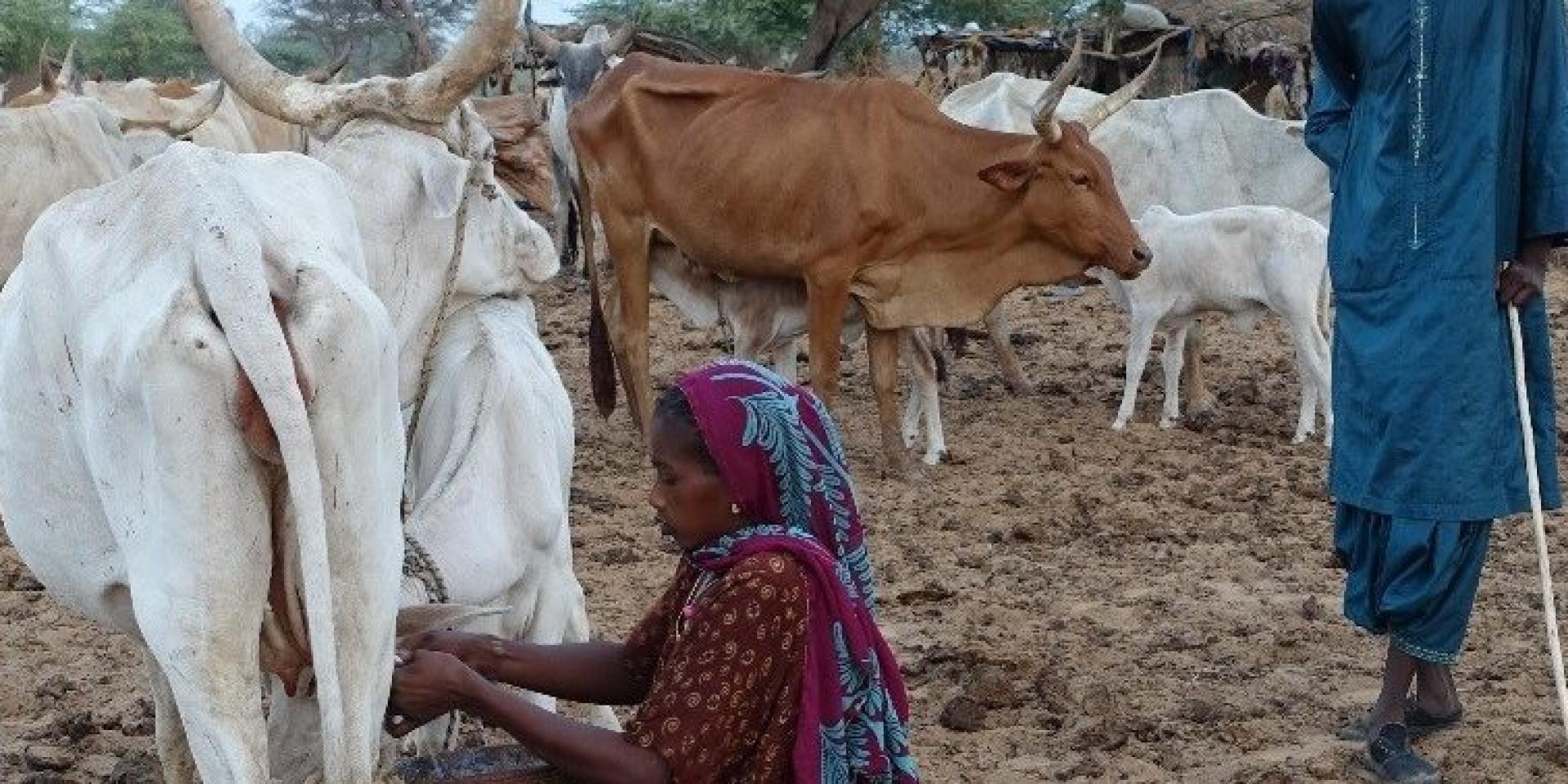
Many surveys ask who in the household makes key decisions, but most fail to ask why.
This post was first published by the CGIAR Research Program on Policies, Institutions, and Markets (PIM).
In a recent World Development paper, Tanguy Bernard, Chery Doss, Melissa Hidrobo, Jessica Hoel, and I investigate respondents’ perceptions of why a particular person makes key production and consumption decisions. Using data from dairy farmers in rural Senegal, we analyze how the identity of the decision-maker (husband, wife, or the couple together) and the rationale for decision-making are related to milk production, hemoglobin levels among children, and satisfaction with decisions. Outcomes that appear to be related to the identity of the decision-maker(s) are actually driven by decision-making typologies. Our results highlight the importance of identifying not just who makes decisions but also why.
The vignettes
To understand why particular individuals are involved in making different decisions, we develop vignettes, or survey instruments used to measure concepts that are more easily defined through examples (see Gary King’s website for discussions and examples). While researchers have used vignettes to measure topics ranging from subjective well-being (Ravallion, Himelein, & Beegle, 2016) and women’s agency (see Donald, Koolwal, Annan, Falb, & Goldstein, 2017 for a review) to bias against women politicians (Beaman et al., 2009) and risk aversion (Barter & Renold, 1999), we are the first to employ vignettes to analyze the processes of household decision-making.
Prior to conducting the vignettes, we ask a relatively standard set of questions about who makes decisions concerning (a) the distribution of concentrated food among lactating cows (which we label as “production decision”) and (b) how to spend income from milk sales (which we label as “consumption decision”). Respondents indicate if they or their spouse make(s) each decision alone or together. Next, to understand decision-making processes within households, we develop a typology of households and create vignettes to reflect these typologies. Drawing on the extensive literature on household decision-making, we identify five types of households based on five ways of understanding why certain individuals make decisions within the household. The following categories are not necessarily exclusive, but each has a different key element:
- Unitary model: the same individual (or couple) makes all significant decisions in the household.
- Contribution model: each decision type is made by the person who contributes the most resources for this activity.
- Separate spheres model: individuals within the household are in charge of separate domains.
- Norms model: one is entitled to make a particular decision because of local social norms.
- Most informed model: each decision is made by the individual who has the most information regarding the relevant domain.
We interview husbands and wives separately, asking each to indicate how similar they are to each type of household and then ask which household they most resemble. Their pooled responses are presented in Figures A for production decisions and B for consumption decisions. When husbands are the main decision-makers for production or consumption, it is mostly because they are a unitary household where he makes all the decisions, while when wives are the main decision-makers it is mainly because they are the most informed for production decisions and in charge of separate domains for consumption decisions. These decision-making typologies matter for real world outcomes.
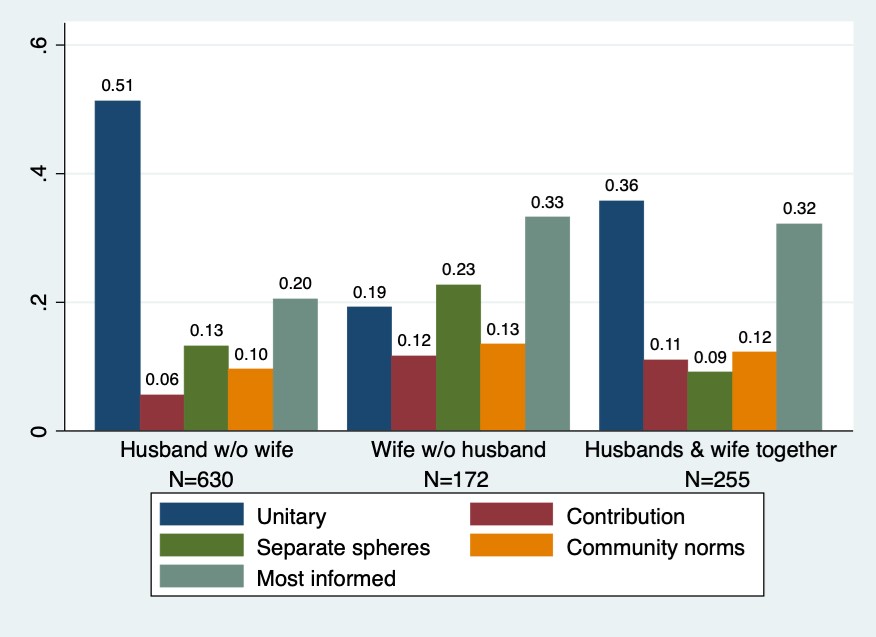
Figure A. Production: Type of household by who decides. This figure presents the distribution of household types for respondents based on their reporting of whether husbands decide without wives how to allocate food among lactating cows, that wives make this decision without husbands, or that couples make this decision together.
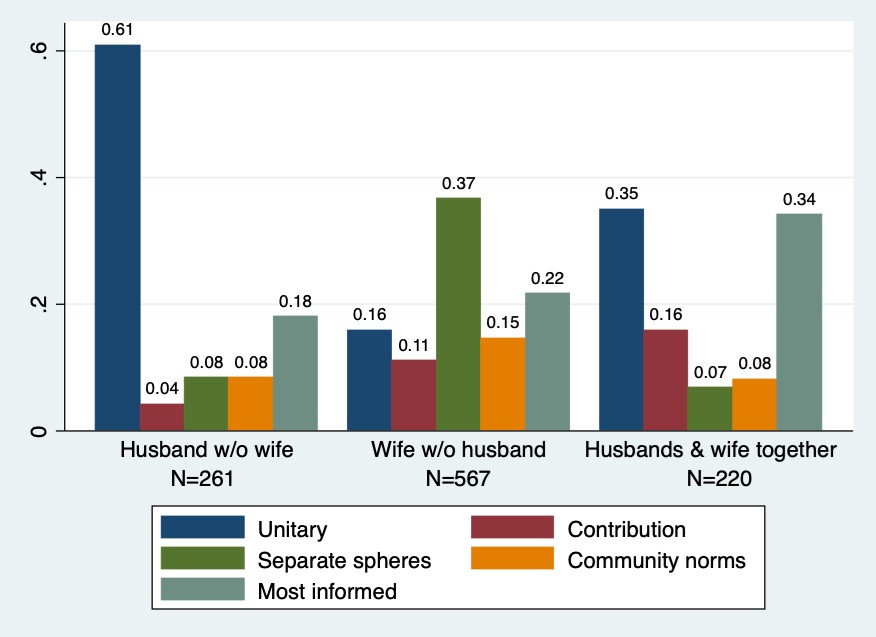
Figure B. Consumption: Type of household by who decides. This figure presents the distribution of household types for respondents based on their reporting of whether husbands decide without wives how to spend money from milk sales, wives make this decision without husbands, or that couples make this decision together.
Lessons learned
Measuring complex household decision-making processes is not easy, but vignettes hold some promise. Based on our experience, we recommend the following to anyone interested in conducting vignettes to understand decision-making processes in households:
Pick a few key household decisions. We analyze one major production decision and one major consumption decision faced by the pastoralist households in our sample, finding that patterns vary across domains. This suggests that researchers should not interpret findings within one domain as indicative of how a household operates in all domains. If your budget only allows for vignettes on one type of decision, be cautious in drawing conclusions regarding other decision-making domains.
Adapt response options for ‘who decides’ to the context of your study. Since the vast majority of the existing literature on intrahousehold bargaining issues focuses on the decisions of husbands and wives, we frame most of our analysis in this perspective. However, the method and instrument that we propose can be extended to other individuals within the household by altering the response options regarding who decides. For example, you may be interested in who makes decisions in households with multiple generations of adults.
Pre-test the vignettes to ensure that the five typologies are relevant. By asking respondents which couples they resemble before asking which couple they most resemble, we are able to analyze correlations across typologies within each household. While there is substantial overlap, none of the typologies are perfectly correlated (see Table A). Using this approach, you may find that it is not necessary to include all five typologies. We also recommend considering whether other rationales drive decision-making processes in different contexts.
Table A
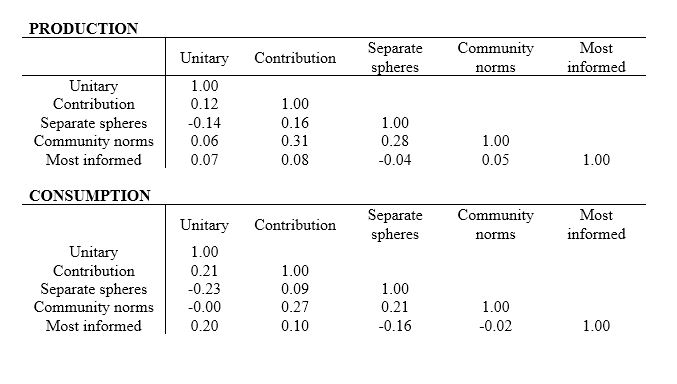
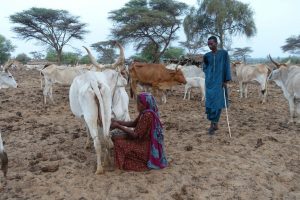
Photo: Melissa Hidrobo/IFPRI
Future research
In this paper, we do not explicitly analyze whether husbands and wives provide different responses (or if wives living in polygynous households respond differently), but we include the responses of both husbands and wives in our analysis. We would have drawn very different conclusions had we only interviewed men. Research suggests that spouses often provide different responses to the same questions about household decision-making (Ambler et al., 2019; Donald et al., 2017; Poutvaara & Schwefer, 2018), but there is room for more work on this topic.
We perform a series of tests regarding the capacity of these vignettes to reliably assess why certain individuals are responsible for specific decisions. We find no evidence of large anchoring effects or systematic gender biases in answering these questions – as opposed to questions regarding who decides, where these biases are more evident. It may thus be useful to develop vignettes to assess who decides.
References
Ambler, K., Doss, C., Kieran, C., & Passarelli, S. (forthcoming). He says, she says: Spousal disagreement in survey measures of bargaining power. Economic Development and Cultural Change. DOI: 10.1086/703082.
Barter, C., & Renold, E. (1999). The use of vignettes in qualitative research. Social Research Update University of Surrey, Summer, 1–25.
Beaman, L., Chattopadhyay, R., Duflo, E., Pande, R., & Topalova, P. (2009). Powerful women: Does exposure reduce bias? The Quarterly Journal of Economics, 124(4), 1497-1540. https://doi.org/10.1162/qjec.2009.124.4.1497.
Donald, A., Koolwal, G., Annan, J., Falb, K., & Goldstein, M. (2017). Measuring women’s agency. Policy Research Working Paper No. 8148.
Poutvaara, Panu; Schwefer, Maximilian (2018): Husbands' and wives' diverging perceptions on who decides, Ifo Working Paper, No. 279, Ifo Institute – Leibniz Institute for Economic Research at the University of Munich, Munich.
Ravallion, M., Himelein, K., & Beegle, K. (2016). Can subjective questions on economic welfare be trusted ? Economic Development and Cultural Change, 64(4), 697–726.
Caitlin Kieran is a Ph.D. student in the Department of Agricultural and Resource Economics at the University of California, Davis. She previously worked as a Senior Research Assistant for the CGIAR Research Program on Policies, Institutions, and Markets (PIM). Her research focuses on how policies and development programs affect and are affected by intrahousehold dynamics. Her current work examines how communication influences information asymmetries between spouses in the Philippines and whether altering spouses’ property rights induces inefficient allocations of productive resources in rural Ethiopia.
This project would not have been possible without funding from the European Union through the CGIAR Research Program on Policies, Institutions, and Markets (PIM), as well as CGIAR Research Program on Agriculture for Nutrition and Health (A4NH), led by the International Food Policy Research Institute.